Smoke & Heat Detector Troubleshooting
Smoke Detector Trouble Conditions
There are several different models of Smoke Detectors. If yours is not listed below, please refer to the Sensor Manual page to locate the user’s manual for your device.
Ademco Honeywell 5806 W3These Trouble Conditions apply to the Ademco Honeywell 5806W3 wireless smoke detector. This smoke detector has 2 LEDs and a sounder to indicate the detector’s status. |
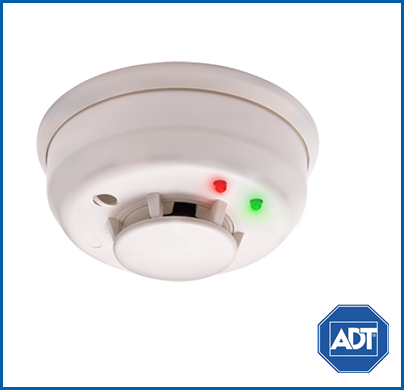 |
|---|
| State | Green LED | Red LED | Sounder | Action |
| Normal (Standby) | Blinks every 10 seconds | Off | Off | The device is operating normally. No action needed. |
| Smoke Alarm | Off | Blinks every 1 second | Pattern | Smoke has been detected. ADT has been contacted. Press the recessed test switch to silence the smoke detector sounder for 5 minutes. If necessary, silence the alarm keypad. Remove the source of the smoke, if it can be done safely. If necessary, fan the smoke detector for a few minutes to further dissipate any smoke or particles. If the device still indicates a problem, it may be necessary to clean it. Please refer to Caring for Your Smoke Detector below. |
| Thermal Alarm (>135o) | Off | Blinks every 4 seconds | Pattern | The unit has detected that the temperature is above 135oF. ADT has been contacted. Press the recessed test switch to silence the smoke detector sounder for 5 minutes. If necessary, silence the alarm keypad. Remove the source of the heat, if it can be done safely. |
| Freeze Trouble (<41oF>) | Off | Blinks every 10 seconds | Off | The unit has detected that the temperature is below 41oF, which could lead to a freeze situation within the premises. Investigate the cause and resolve. |
| Low Battery 0-7 days | Off | Blinks every 45 seconds | Off | The battery power is low. ADT has been contacted. You will be notified of the non-emergency situation. Replace the battery. Please refer to the Smoke and Heat Detector Battery Replacement page. |
| Low Battery 8+ days | Off | Blinks every 45 seconds | Chirp every 45 seconds | The battery power has been low for 8 or more days. Press the Test switch to silence the chirp for 12 hours. ADT has been contacted. You will be notified of the non-emergency situation. Replace the battery immediately. Please refer to the Smoke and Heat Detector Battery Replacement page. |
| Power Up | Blinks every 5 seconds | Blinks every 5 seconds | Off | The device is powering up. The lights will blink for approximately 20 seconds until the unit has completed the power up cycle. |
| Out of Sensitivity | Off | Blinks every 5 seconds | Off | A problem has been detected with the smoke detector. The smoke detector compensates for long term changes in the environment resulting from dust and other factors. This automatic compensation sensitivity needs to be reset by a technician. To schedule service, please call 1-800-ADT-ASAP. |
DSC WS4916These trouble conditions apply to the DSC WS4916 wireless smoke detector. This smoke detector has one LED light and a sounder to indicate the detector’s status. |
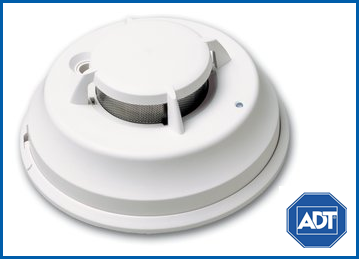 |
|---|
| State | LED | Sounder | Alarm Mode | Action |
| Normal (Standby) | Blinks every 50 seconds | Off | None | The device is operating normally. No action needed. |
| Smoke Alarm | Blinks every 1 second | Pattern or steady | In Alarm | Smoke has been detected. ADT has been contacted. Press the test switch to silence the smoke detector sounder for 5 minutes. If necessary, silence the alarm keypad. Remove the source of the smoke, if it can be done safely. If necessary, fan the smoke detector for a few minutes to further dissipate any smoke or particles. If the device still indicates a problem, it may be necessary to clean it. Please refer to Caring for Your Smoke Detector below. |
| Thermal Alarm (>135o) | Blinks every 1 second | Pattern or Steady | In Alarm | The unit has detected that the temperature is above 135oF. ADT has been contacted. Press the recessed test switch to silence the smoke detector sounder for 5 minutes. If necessary, silence the alarm keypad. Remove the source of the heat, if it can be done safely. |
| Trouble | Off | Chirp | Trouble Signal | A problem has been detected with the smoke detector. The smoke detector compensates for long term changes in the environment resulting from dust and other factors. This automatic compensation sensitivity needs to be reset by a technician. To schedule service, please call 1-800-ADT-ASAP. |
| Low Battery 0-7 days | Blinks every 50 seconds | Off | Low Battery | The battery power is low. ADT has been contacted. You will be notified of the non-emergency situation. Replace the battery. Please refer to the Smoke and Heat Detector Battery Replacement page. |
| Low Battery 8+ days | Blinks every 50 seconds | Chirp | Low Battery | The battery power has been low for 8 or more days. Press the Test switch to silence the chirp for 12 hours. ADT has been contacted. You will be notified of the non-emergency situation. Replace the battery immediately. Please refer to the Smoke and Heat Detector Battery Replacement page. |
| Tamper | Blinks every 50 seconds | Off | Tamper | An attempt has been made to remove the Smoke Detector, causing the Tamper switch to be depressed. ADT has been contacted. You will be notified of the non-emergency situation. Take appropriate precautions or replace the smoke detector properly. Note: Tamper switch is recessed behind sensor body; it can be seen in square opening above batteries. |
Testing the Smoke Detector
To test that your smoke detector is functioning properly:
- Place your system in Test mode. Please refer to the System Test page.
- Locate the Test Switch on the detector housing. This may be a recessed switch or a visible button.
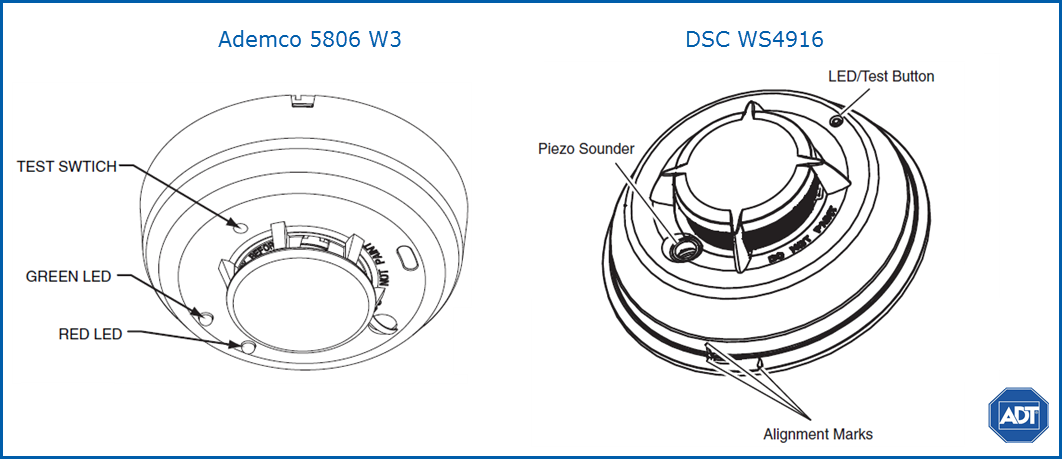
- Depress the Test Button, if present. For a recessed test switch, use a small screwdriver or Allen key (no more than 0.18″ diameter) to push and hold the recessed test switch for at least 5 seconds. The smoke detector LED should blink once per second and the smoke detector sounder (not the system siren) sound within 3 seconds, indicating that the detector is functioning properly. Release the Test Button or remove the tool from the recessed switch to silence the smoke detector sounder.
- Remove your system from Test mode. Please refer to the System Test page.
Heat Detector Trouble Conditions
Heat Detectors do not have LEDs or sounders to indicate trouble conditions. Any trouble conditions detected will show on your alarm keypad. Note: the actual message will vary depending on your keypad model. Please refer to the System Panel Troubleshooting page for details about your keypad model. |
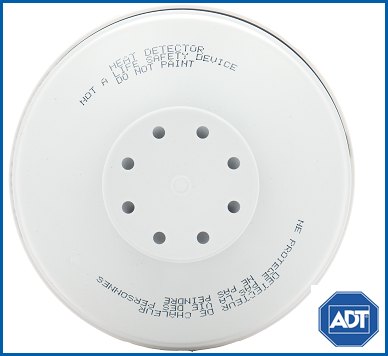 |
|---|
| State | Alarm Mode on Keypad | Action |
| Normal (standby) | None | The device is operating normally. No action needed. |
| Heat Alarm | Alarm for Heat Detector Zone | Heat in excess of 135o F OR an increase in temperature in excess of 15o F per minute has been detected. ADT has been notified of the alarm. Take appropriate action. |
| Low Battery | Low Batt signal for the Heat Detector zone | The battery power is low. ADT has been contacted. You will be notified of the non-emergency situation. Replace the battery. Please refer to the Smoke and Heat Detector Battery Replacement page. |
Testing the Heat Detector
Because many heat detectors are designed for a one-time use, it is not recommended that you test them yourself. If you have concerns about the readiness of the heat detector, please call 1-800-ADT-ASAP for assistance.
How They Work
Smoke Detectors
There are three common styles of Smoke Detectors:
- Ionization: Detects fast, flaming fires caused by chemicals, petroleum based products, paper and wood. It is equipped with two metal plates and a small amount of radioactive material to ionize air. When smoke passes through the device, it interrupts the ionization and triggers the alarm.
- Photoelectric: Detects visible smoke, slow burning, smoldering fires caused by drapes, clothes, paper and wood. It operates with a light beam inside; smoke particles break the light beam and triggers the alarm.
- Dual: Includes both Ionization and Photoelectric sensors.
Smoke detectors should be mounted on a ceiling or high on the wall. The National Fire Protection Association recommends that there be at least one smoke detector on each floor, including outside sleeping areas, in every bedroom and in the basement.
Heat Detectors
There are three common styles of Heat Detectors:
- Rate of Rise: Recognizes a rapid increase of heat within its installed area. When the ambient temperature, as measured by its internal thermostat, rises more than 15o F in one minute, the alarm is triggered. Some types of heat detectors may use a sealed chamber. As the temperature rises, the air within the sealed chamber expands. Should the chamber air expand faster than it can escape through the calibrated vent, the diaphragm is depressed, and the electrical contact closes the circuit, triggering the alarm.
- Fixed Heat: Activates once the temperature reaches the defined setting. This type will activate once, and then need to be replaced. The fixed temperature element reacts to heat by responding to a specific temperature setting (135º F or 194º F). The detection method is based on the spring action of a metal contact held to the metal chamber by a fusible alloy. When the temperature reaches the alloy’s melting point, the metal contact springs up, closing the circuit and triggering the alarm.
- Dual: Includes both Rate of Rise and Fixed Heat sensors
Heat detectors are installed normally in areas such as garages, basements, attics, kitchens, boiler rooms, bathrooms and smoking areas. They are used for property protection and not life safety.
Caring for the Smoke Detector
Your smoke detector is sensitive to dust and particles in the air. Before performing any activity near the smoke detector which may cause excessive dust or smoke, such as remodeling or soldering, place your system on test to avoid a false alarm. Please refer to the System Test page. If remodeling or other activity will create excessive dust for an extended period, please either remove the smoke detector or cover it with a plastic cover before beginning construction. Do not paint the smoke detector; this will cause it to be non-operational.
Dust and other particles will collect on the smoke detector over time during normal use. The smoke detector should be cleaned periodically cleaned to remove these accumulated particles. The following cleaning steps refer to the wireless Ademco Honeywell model 5806W3. Further information is available in the Ademco Honeywell 5803W3 device manual. |
 |
|---|
To clean the smoke detector:
- Place your system in Test mode. Please refer to the System Test page.
- Remove the detector housing from the base by twisting counter-clockwise.
- Remove the battery from the unit.
- Wait at least 20 seconds to ensure proper power-down sequence.
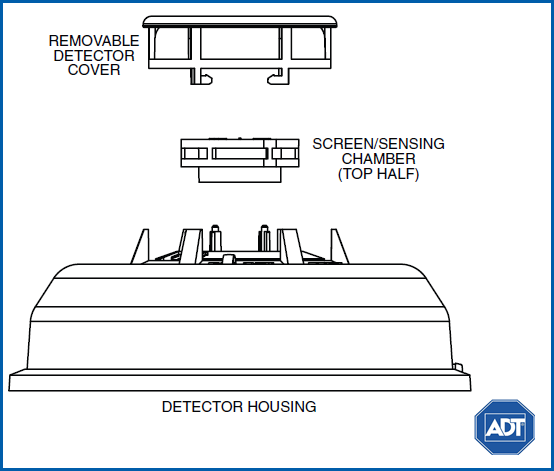
- Remove the detector cover by turning counter-clockwise.
- Vacuum the cover or use canned air to remove any dust or debris.
- Remove the top half of the screen/sensing chamber by lifting straight up.
- Vacuum or use canned air to remove any dust or particles that are present on all chamber sections.
- Replace the top half of the screen/sensing chamber by aligning the arrow on the screen/sensing chamber with the arrow on the housing. Press down firmly until the screen/sensing chamber is fully seated.
- Replace the detector cover by placing it over the screen/sensing chamber and turning it clockwise until it snaps into place.
- Reinstall the battery into the battery compartment noting proper orientation. The red and green LEDs will flash once every 5 seconds for approximately 20 seconds until the power-up cycle is complete.
- Reinstall the detector housing onto the base.
- Test the smoke detector. Please refer to Testing the Smoke Detector below.
- Remove your system from Test mode. Please refer to the System Test page.
NOTE: If the detector indicates a maintenance trouble after the power-up sequence is complete, remove the battery for 20 seconds and then reinstall.
Caring for the Heat Detector
The Heat Detector is used in areas where a smoke detector may not be feasible, such as a kitchen, basement, attic or smoking area. The ambient temperature where the Heat Detector is located should not exceed 100o for an extended period of time.
A heat detector employing a Rate of Rise threshold will activate if the temperature rises 15o or more per minute. If an alarm temperature threshold is available, it is usually set at 135o or 194o. An alarm will be triggered if any threshold is exceeded. Due to the design of the heat detection mechanism, once an alarm has been triggered, the heat detector must be replaced.
Do not paint the heat detector as this will interfer with the heat sensing mechanism.
Related Topics
Smoke and Heat Detector Battery Replacement
Here is information on how to replace the battery in your device
Finding the Right Sensor Battery
Here you can locate the correct size and type of battery for your sensor
System Panel Troubleshooting
Here is information about how smoke and heat alarms may affect your system and keypad, as well as how to reset your alarm system after an alarm has occurred.
Testing Your System
Here are instructions for placing your system in Test mode, and for removing it from Test mode once the test is complete.
